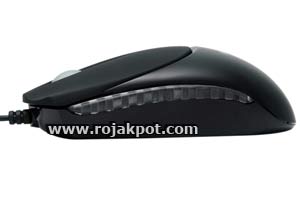Side Buttons
If you are looking for side buttons, then this is the wrong mouse for you. The Krait comes with zilch, nada, zero side buttons. Both sides of the mouse are entirely occupied by the semi-translucent plastic rails.
All you get with the Krait are the two large buttons, and the center scroll wheel which doubles as a third button.
Note that this mouse is targeted at a specific segment of the market - real-time strategy (RTS) or massively multiplayer online games (MMOG) gamers. For such gamers, there's far less use for side buttons. It would be easier to play with both a keyboard and a mouse, instead of relying solely on multiple mouse buttons.
The Optical Sensor
 |
Instead of the laser sensor used in the Razer Copperhead, the Krait uses a more common optical sensor.
Made by Razer Precision, this optical sensor has a resolution of 1600 dpi and a frame rate of over 6400 fps or 5.8 megapixels per second.
It also has a motion detection speed of up to 40 inches per second and 15 G.
The sensor uses a red light which never goes off into sleep mode - a feature Razer calls Always-On. It's supposed to ensure an instantaneous response, albeit at the expense of saving power.
Mouse Cord
 |
Like all gaming mice, the Krait uses a mouse cord for connectivity. Unlike other mice though, the Krait sends 16-bits of data.
This bypasses the slow 125 Hz polling rate supported by Windows XP and allows for much faster response time.
Also unique is the fact that the Krait comes with a gold-plated USB connector! A real bling-bling factor for LAN parties. But whether it actually helps in your gaming experience is another matter altogether.
16-Bit Data Path
With a 1600 dpi laser sensor that can capture over 6,400 frames per second, the Razer Krait can deliver a lot of data each second.
Unfortunately, Windows XP limits the frequency at which the USB bus can be polled to only 125 times per second. So, as far as Windows XP systems are concerned, the 1600 dpi sensor is overkill because the USB interface cannot handle the flow of data.
To circumvent this limitation, Razer made use of 16-bits data packets instead of the usual 8-bits or 12-bits data packets. This allows the Krait to make full use of its 1600 dpi sensor while remaining within Windows XP's USB polling limit of 125Hz.
<<< The Razer Krait, Specifications : Previous Page | Next Page : The Krait In Action, Side By Side Comparison >>>







 Add to Reddit
Add to Reddit


